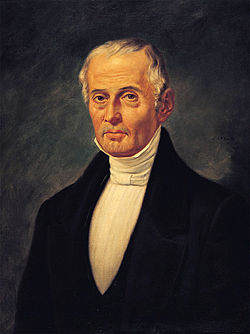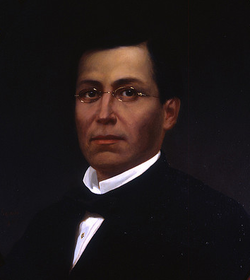Ideology

Federalism
The Liberals supported organizing the nation as a federation where each state contained an element of sovereignty shared with the federal government. The liberal Spanish Constitution of 1812, promulgated during the last years of colonial rule, divided New Spain into provincial deputations with popularly elected assemblies. [2] Federalism can trace itself back to these provincial deputations or committees which fostered a spirit of provincialism and formed local political oligarchies reluctant to relinquish their newfound influence. [3] Jalisco, the states of the North, and Yucatan were already beginning to form their own prominent local identities during colonial times. The Mexican provinces of Central America broke away on their own during the fall of the First Mexican Empire. [4]
A de facto state of federalism already existed during the Supreme Executive Power, tasked with drafting the first constitution for independent Mexico. [5] The arguments for integrating federation into the new constitution prevailed, motivated by the long struggle during the war of independence to seek as much autonomy as possible, and also an eagerness to reap the salaries that would accompany local bureaucracies. [6]
Federalism would end for the moment in 1836, when the Conservatives promulgated the Siete Leyes, which replaced the states with departments controlled from Mexico City. In response, many states revolted against such an arrangement which led to the secession of Texas and eventually Yucatan. Revolts to secede or to restore the Liberal system of federalism would continue to agitate the Conservative Centralist Republic of Mexico to its very end, and the Constitution of 1824 would be restored in 1846 after the outbreak of the Mexican American War.
The Plan of Ayutla overthrew the dictatorship of Santa Anna and brought a Liberal government to power in 1853. A motion to once again restore the Constitution of 1824 failed by one vote, [7] and work once again began on drafting a new constitution. The subsequent Constitution of 1857 would once again be federalist, and would remain in effect until the Mexican Revolution in the early twentieth century.
Anti-Clericalism

Liberal efforts at disestablishing the Catholic Church began with the liberal presidency of Valentín Gómez Farías in 1834. The government shut down church schools, assumed the right to make clerical appointments to the church, and shut down monasteries. [8] It was at this point that the government began proposing the nationalization of church lands as well. [9] The Liberal governor of Mexico State, Lorenzo de Zavala would also carry out anti-clerical measures, including the suppression of monasteries. Conservative backlash led to the fall of the Gómez Farías administration.
The issue of nationalizing church lands was brought up again in 1847 by Gómez Farías once more who had once again found himself in the presidency during the Mexican–American War. This time Gómez Farías urged the nationalization of church lands as a means of funding the war effort, but the efficacy and prudence of such a measure was questioned by Conservatives, even by moderate liberals. [10] There were clashes in the cabinet over the matter, [11] and another Conservative revolt known as the Revolt of the Polkos once again toppled Gómez Farías.
A final and ill-fated Conservative effort to fight back against the anti-clerical measures of the Liberal Party took place during the pivotal La Reforma period which was inaugurated by the Plan of Ayutla that brought the liberal Juan Alvarez to power. This time it was not only the nationalization of church lands, but the question of religious freedom, and the jurisdiction of canon law over clergy that was brought to fore during the discussions regarding the drafting of the Constitution of 1857. Church properties not related to religious functions were nationalized, priests remained under the jurisdiction of canon law only in non-civil cases, and for the first time a Mexican Constitution did not declare Catholicism as the state religion.
Conservative backlash would trigger the Reform War, and it was during the war that the liberal president Benito Juarez went much further than the earlier reform measures by nationalizing all the remaining church properties in order to fund the war effort. The Conservatives would eventually lose the war in 1860, and the liberal measures remained entrenched.
Republicanism

The Liberal Party was staunchly republican throughout its entire existence which did not always put it in opposition to the Conservative Party. Both parties joined in condemning José María Gutiérrez de Estrada when he suggested in 1840 that Mexico ought to invite a foreign monarch to establish a Mexican monarchy. [12] Mexican historian Justo Sierra has argued that the unpopularity of monarchy caused the Conservatives to endorse republicanism lest the Liberal Party be perceived as the only republican party. [13]
In 1845, the perception that President Mariano Paredes was considering constitutional change towards monarchy triggered a storm of opposition in the liberal press. [14] Many liberal newspapers began changing their names to support republicanism. El Monitor Constitucional (The Constitutional Monitor) changed its name to El Monitor Republicano (The Republican Monitor). El Siglo XIX (The Nineteenth Century) changed its name to El Republicano (The Republican). Carlos Maria Bustamante began to publish a newsletter titled Mexico no quiere rey y menos a un extranjero, (Mexico doesn't want a king, let alone a foreign one). [15]
Republican critics of Paredes also pointed out that monarchy was unsuitable to the country because Mexico had no nobility to support such an institution. "With powerful arguments they maintained that the idea of a monarchy in Mexico was not only contrary to the wishes of the Mexican people, but also one that was not at all feasible, there being no such thing as a nobility in the country." [16] Even the Conservative statesman, Antonio de Haro y Tamariz, agreed with these points, sarcastically suggesting that the government start granting titles to generals. [17]

The Liberal Party was in power when the Second French Empire launched an invasion of Mexico, the Second French Intervention, in 1861 with the intention of overthrowing the government of Mexico and replacing it with a monarchical client state, the Second Mexican Empire, a scheme that gained the collaboration of the Conservative Party, which previously however had expressed republican principles, [18] causing the Liberal ambassador to the United States, Matias Romero to remark that “the French government has been and is, then, the true and only author of the project to establish a monarchy in Mexico, which can only be conceived...by persons who did not know the present situation of the republic and the ideas and tendencies of its people, or who believe the Mexican nation is an automaton with which one may do as one pleases. “ [19] Five years of war would follow during which the French invaders struggled to gain control of the entire country, made worse by the end of the American Civil War in 1865, which allowed the United States to supply materiel to the Mexican Republic and place diplomatic pressure on France to leave the continent. Emperor Maximilian was captured, tried, and executed by the Liberal government in 1867.





